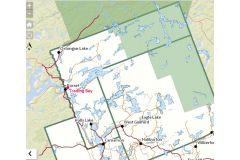Trading Bay History
TRADING BAY HISTORY
Location: Ridout Township, Muskoka (part of Lake of Bays)
Origin of the Official Name: Geographic Board of Canada - Ont 1962)
The fur trade was one of the first concrete relationships that arose between Natives and non-Natives in Canada. Fur traders were almost always English or French and the trappers were Aboriginal. However, in Haliburton, many of the trappers were White too (Source: Murray, F. (1963) The Publications of the Champlain Society: Muskoka and Haliburton 1615-1875. Toronto: The Champlain Society. xcv). There is evidence of the fur trade in Haliburton remembered in some of the lake names. Trading Bay and Trading Lake (one of the names given to Lake of Bays) are two such lakes which tell of the (hi)story of the fur trade in Haliburton. “Alexander Shirreff said in 1829 that Trading Lake (now Lake of Bays) appears to have been long a principle station of the traders” (Source: Murray, F. 1963 op cit xcvii).
Also Known As:
• Trading Lake (MNR archives)
• Lake of Bays (MNR archives)
• Ten Mile Bay (in Stanhope archives "Map Shewing location of the river improvements 1893)
Acknowledging the land we are on and so grateful to be able to enjoy
Source: Megan C Rowley Kawagama and Bear Lakes - KLCA Facebook
A water-based people, the Anishinaabeg – the original people of this region – were a hunter-gatherer society that often travelled here to the narrows at Trading Bay (Lake of Bays). The area that is now Dorset was a special, spiritual place abundant in natural resources. For thousands of years the Anishinaabeg set up small camps here harvesting maple syrup and birch bark, fishing and trading in the spring and summer, and hunting and trapping during the fall and winter. Eventually, the Anishinaabeg realized that their hunting and harvesting rights and territory had been lost through a series of treaties. They continued to travel to the region to work as fishing and hunting guides and trading with seasonal tourists and cottagers. The descendants of the Anishinaabeg are members of the seven First Nations of the Williams Treaties (1923), the nearest of which is the Chippewas of Rama First Nation. The legacy of the original inhabitants lives on through the many landmarks, rivers, lakes, and islands that bear Anishinaabemowin (Ojibwe) place names.